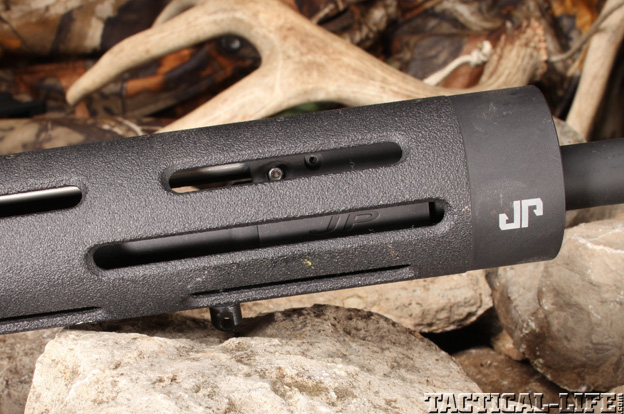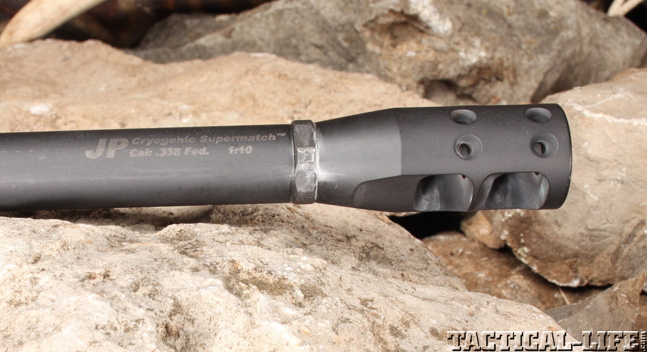The weather was unseasonably warm and windy for early November in western Kentucky. Opening day of rifle season came and went with a half dozen yearling bucks keeping themselves busy chasing does that weren’t quite ready to breed. I took a break from hunting in anticipation of some cold weather predicted for later that week. When the weekend rolled around, the thermometer read 27 degrees before sunrise. The morning came and went with only a nubbin buck to show for it.
When it was time to head back to the woods for the evening hunt, I picked a secluded spot that hadn’t seen a hunter for three years. Standing behind my pickup I shrugged into the shoulder straps of a Summit climbing stand. I looked up as I adjusted the stand’s carry straps and watched a nice four-pointer walk into the cut soybean field 90 yards away—he was oblivious. I reached for the JP Enterprises rifle lying on my truck’s tonneau cover to get a better look. I cranked up the scope’s power and watched the big-bodied buck as he picked his way across the field. He wasn’t the buck I was after. I waited until he had crossed the field close enough to its far edge, so that he wouldn’t spook toward the section of woods I wanted to hunt. Screwing the Leupold’s power ring back down to 4.5, I started walking across the field. When I hit the gun’s release button and the bolt slammed home a fresh round, the buck snapped his head up. My walking form was all he needed to start his dash for safety.
When I reached the woods’ edge, I took the toe of my boot and stepped on the base of a big saw brier hanging over the entrance to a grown-up logging road. The first thorny obstacle out of the way, I picked a path through blackberry vines, following a faint deer trail. After several yards the past summer’s overhead canopy had retarded sunlight enough that the logging road was more distinguishable and the briers thinned out. Careful not to let any branches smack the metal stand on my back, I crept forward. A hundred yards into the timber I found a fresh scrape. Wanting to get downwind of the scrape, I crept another 75 yards through the thick brush before I found an acceptable tree to hang my climber.
Advertisement — Continue Reading Below
The stand in place at the bottom of the tree, I reached to unload the rifle before making the climb, and that’s when I caught movement along my back trail. I stepped up onto the stand’s platform to see better and waited for the first doe to step clear. She kept looking behind her, so I knew another deer was following her. Five minutes passed before a second mature doe materialized from the thick brush. One doe squatted and urinated in the scrape I passed only minutes before. They milled around about 10 minutes, and then eased back up the trail toward the soybean field.
I broke one of my gun-handling rules when I double-checked the rifle’s safety and slung it over my back. I knew that a buck was bedded within earshot of my location from the way the does acted. Silently raising the hand climber, I sat down in slow motion and pulled up the platform with my feet. It took about 10 minutes to climb ultra slowly to 15 feet where I could see above the brush. When I reached around the tree to cinch down the seat climber, I heard a deer grunt in the thick valley below me. Raising the rifle sling over my head, I weaved my left arm back through the sling, rested the rifle against the tree I was in, and waited for the deer to show.
Moments later, a branch snapped deep within the thicket below. I mentally connected the two sounds to get an idea of which way the deer was moving. Seconds later, another grunt confirmed the direction the unseen animal was traveling. It was moving in the direction of the scrape. The sun glinted off white antler 80 yards away. I peered through the scope and found the buck’s head. I could clearly make out the tip of his left antler beam, one eye and the tip of his nose. He stood motionless feet away from the scrape for 15 minutes, just his ears scanning, nostrils flaring and as he sucked in the doe’s scent. No shot presented itself, and I couldn’t see enough of the buck’s rack to determine if he was at least a 2.5-year old.
Advertisement — Continue Reading Below
Pre-Hunt Zeroing
Earlier that day, I decided that I wasn’t going to be too picky and hold out for an older buck. I wanted to get some deer blood on this JP LRP-07H chambered in .338 Federal. The rifle was already sighted in, but I hadn’t had a chance to chronograph any loads with this rig. I set up a chronograph on my range back at the cabin to get some more hard data on this rifle and shoot five-shot groups. A Bulls Bag rest supported the rifle while a standard sandbag was used as a rear rest. This setup was positioned on a sturdy bench, and shooting for groups was conducted at 100 yards. The temperature was 42 degrees, and a slight 4 mile-per-hour breeze blew from left to right. The optic used for shooting groups and hunting was a Leupold VariXIII 4.5-14X with an adjustable 50mm objective.
Since this was a hunting rifle, the first thing I did was remove the muzzle brake. JP LRP-07H muzzle brakes are a dream to shoot from the bench with hearing protection, but I didn’t want to experience the muzzle blast on unprotected ears. JP supplies a muzzle thread protector with each rifle for just such an application.
Ten shots of Federal’s Premium loaded with 185-grain Barnes Triple-Shock bullets averaged 2,610 fps. This load averaged sub-MOA for five-shots groups with the smallest group measuring 0.66.
Advertisement — Continue Reading Below
One of the reasons that I selected this load for hunting was its tendency to group well and keep the same point of impact from a cold barrel. A week prior to the first day I shot groups, I was fine tuning the zero to impact 2.75 inches above point of aim at 100 yards. I fired two shots to confirm my scope adjustments and went hunting. The next morning after a few hours on stand, I fired three more shots at the same target and they printed a tight five-shot group. According to the ballistic calculator in RCBS.Load, an impact 2.75 inches high at 100 yards would put it dead on at 216 yards. At 300 yards I confirmed that the shot impacted 8 inches below point of aim—at 400 yards it was hitting 25 inches below point of aim. (One of my favorite stands overlooking a frequent deer crossing in my back soybean field was 330 yards distant, which would put this load 12 inches below point of aim if a shot presented itself there.)
The other factory load I tested was Federal Premium loaded with 210-grain Nosler Partitions. The average velocity was clocked at 2,420 fps, while the standard deviation was 11 fps and the extreme spread was 29 fps. I was somewhat surprised by this load. The small standard deviation had the potential for producing tight groups, but this rifle did not like this load—the tightest group measured 2.42 inches.
Federal Cartridge and Sako teamed up in 2006 to create a new cartridge, the .338 Federal, which is a .33 caliber cartridge based on the .308 Winchester. That being the parent case, this is an excellent hunting caliber for AR-10-style modern sporting rifles. Fans of the .308 Winchester for deer hunting should take a long, hard look at this relatively new cartridge. The .338 Federal is no slouch when compared to other cartridges with similar powder capacities that are tasked for deer or black-bear hunting. The .338 Federal produces similar terminal energy and muzzle velocity to the 7mm Remington Magnum in bullets weighing the same, but it kicks considerably less. It will outperform a .30-06 too. When compared to a .300 Winchester Magnum with bullets of the same weight, the .338 Federal approaches the bigger cartridge’s muzzle energy with about 33 percent less recoil.
Advertisement — Continue Reading Below
The Shot
I toyed with the idea of shooting the buck in the head if a shot presented itself. Recalling that the bullet struck 2.75 inches high at 100 yards, I would need to hold the crosshairs just above his jaw line to dot his eye at 80 yards. This whitetail buck was giving me way too much time to contemplate as he stood transfixed. Still, I hadn’t seen the other half of his rack, so I tucked the headshot notion away. As I did so, the buck turned and took a step away from me and lowered his head to the ground. This gave me a good look at his rack and I counted eight points and a width slightly over 16 inches. Trouble was, he was walking away at a slight right-to-left angle. I moved the crosshairs ahead of his travel and found a 4-inch wide gap through the trees at his shoulder’s height at 85 yards. When he obliged, I squeezed the trigger and ran a 185-grain Barnes through his last rib. The shot pulverized his lungs and exited the off-side shoulder. I couldn’t see him run, but I smiled when I heard him crash.
Confident of the shot I didn’t wait the customary 30 minutes to start trailing. And, not wanting to tempt the hunter-safety gods further, I unloaded the rifle and lowered it on my haul rope. The buck didn’t go far, maybe 35 yards before he ran out of gas. The sun was just ducking below the trees when I stepped out of the woods toward the truck. I made quick work of the next set of chores and was heading back to the cabin on my four-wheeler with a nice field-dressed buck riding on the back rack with just enough light to drive.
With the passing of every deer season my whitetail tally taken with the “modern sporting rifle” keeps climbing. Pleased with a freezer full of venison, I was very happy with the performance of JP Enterprises’ JP LRP-07H chambered in .338 Federal. This marriage of a superbly accurate rifle with a highly effective cartridge has a new fan, and I’m sure you will become one too when you experience it firsthand. For more information, visit jprifles.com or call 651-426-9196.
Advertisement — Continue Reading Below






























